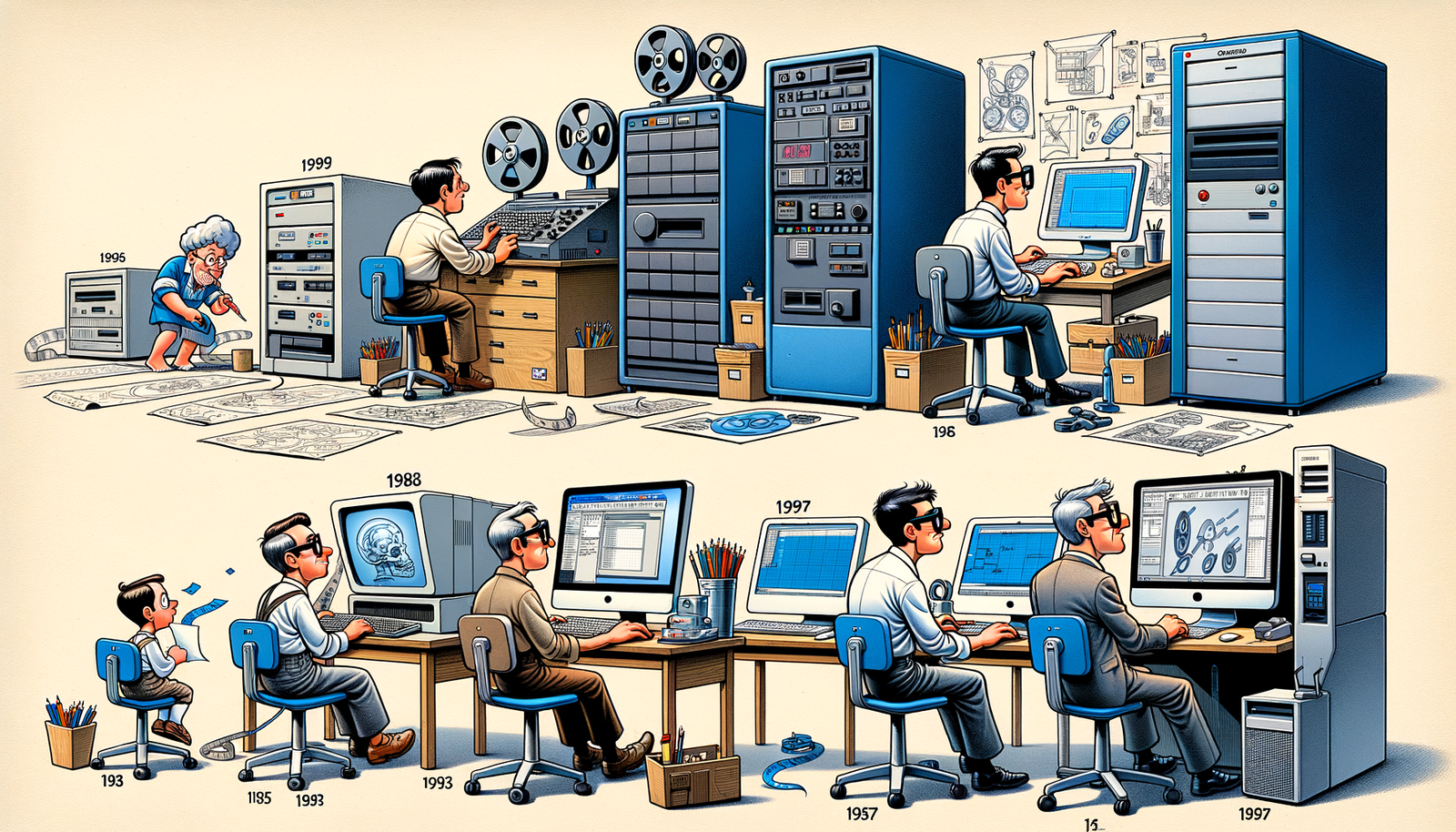Your Cart is Empty
Customer Testimonials
-
"Great customer service. The folks at Novedge were super helpful in navigating a somewhat complicated order including software upgrades and serial numbers in various stages of inactivity. They were friendly and helpful throughout the process.."
Ruben Ruckmark
"Quick & very helpful. We have been using Novedge for years and are very happy with their quick service when we need to make a purchase and excellent support resolving any issues."
Will Woodson
"Scott is the best. He reminds me about subscriptions dates, guides me in the correct direction for updates. He always responds promptly to me. He is literally the reason I continue to work with Novedge and will do so in the future."
Edward Mchugh
"Calvin Lok is “the man”. After my purchase of Sketchup 2021, he called me and provided step-by-step instructions to ease me through difficulties I was having with the setup of my new software."
Mike Borzage
Design Software History: The Pioneering Role of IBM in the Evolution of Design Software and CAD Systems
September 25, 2024 4 min read


The Early Days of IBM and Design Software
IBM’s Founding and Initial Focus
The International Business Machines Corporation, widely known as IBM, was established in 1911 as the Computing-Tabulating-Recording Company (CTR) through the merger of four companies. The founding visionaries, Thomas J. Watson Sr. and later his son, Thomas J. Watson Jr., played pivotal roles in steering the company towards computing innovations. Initially, IBM focused on hardware, particularly on mechanical tabulating machines designed for business use. These machines employed punched card systems for data processing, reflecting the era’s emphasis on physical data handling and computation.
IBM's Entry into Computing
In the 1950s and 60s, IBM transitioned from its earlier focus on punched card systems to electronic computers. This shift marked the beginning of a significant era in computing. The introduction of the IBM 701 in 1952, known as the Defense Calculator, was IBM's first commercial scientific computer, followed by the IBM 704 in 1954, which introduced the use of floating-point arithmetic in computing. These early computers were designed for scientific and military applications but also laid the groundwork for future commercial and industrial uses.
Collaborations with Academic Institutions
IBM’s collaborations with academic institutions were crucial in advancing computer graphics and early concepts of Computer-Aided Design (CAD). Notably, IBM partnered with the Massachusetts Institute of Technology (MIT) and other leading universities. These partnerships supported extensive research in computer graphics, setting the stage for breakthroughs in CAD. Through these collaborations, IBM helped pioneer the basic principles of digital design, which later evolved into sophisticated CAD systems.
IBM's Role in the Development of Early CAD Systems
Project Genesis: The Birth of CAD
The development of IBM’s first CAD system, known as DAC-1 (Design Augmented by Computers), marked a significant milestone. Led by key figures such as Douglas T. Ross, the DAC-1 project introduced the concept of automating design processes using computers. Ross's work on the APT (Automatically Programmed Tool) language further exemplified early efforts to simplify complex design tasks through programming. These pioneering efforts laid the foundation for modern CAD systems, enabling more efficient and accurate design and manufacturing processes.
IBM and the Aerospace Industry
IBM’s collaboration with the aerospace industry, particularly with companies such as McDonnell Aircraft, was instrumental in the adoption of CAD. The complex nature of aerospace components necessitated advanced design tools. IBM’s CAD systems were implemented to design intricate parts and assemblies, significantly improving precision and reducing design cycle times. These early applications of CAD in aerospace demonstrated its potential and spurred further development and adoption across various industries.
The Impact of IBM 360 Series
The introduction of the IBM System/360 in 1964 revolutionized the computing world and had a profound impact on the evolution of design software. The System/360, a family of mainframe computer systems, provided a versatile platform for running a wide range of applications, including CAD. This series facilitated the development and deployment of CAD software, making it accessible to a broader range of industries. Its robust architecture and compatibility features helped standardize computing, thereby supporting the growth of advanced design applications.
Expansion and Innovations in the 1980s and 1990s
The Move to Personal Computers
The 1980s and 90s witnessed a significant shift from mainframes to minicomputers and personal computers (PCs). IBM played a crucial role in this transition with the introduction of the IBM PC in 1981. The IBM PC democratized computing, making powerful computational tools more accessible to smaller businesses and individuals. This democratization also affected CAD, as more users could now afford and utilize design software on personal computers, leading to widespread adoption and innovation in the field of design software.
IBM and CAD/CAM Integration
During this period, IBM also contributed to the integration of CAD and CAM (Computer-Aided Manufacturing). The development of CIM (Computer Integrated Manufacturing) facilitated the seamless flow of information between design and manufacturing processes. IBM’s partnerships with major CAD software vendors like Dassault Systèmes (developers of CATIA) and PTC (known for Pro/ENGINEER) exemplified this integration. These collaborations enabled the development of comprehensive solutions that combined design, engineering, and manufacturing into a cohesive system.
IBM’s Software Initiatives
In addition to partnerships, IBM developed its own CAD software, such as CADAM (Computer-Augmented Design and Manufacturing). CADAM introduced significant enhancements in 3D modeling and solid modeling capabilities. These advancements allowed designers to create more complex and accurate models, leading to improved product development cycles. IBM’s commitment to software innovation during this era underscored its role as a leader in the CAD industry.
IBM’s Legacy and Continuing Influence in Design Software
IBM and PLM (Product Lifecycle Management)
As CAD evolved, it gave rise to Product Lifecycle Management (PLM) systems. PLM encompasses the entire lifecycle of a product, from conception to disposal, integrating people, processes, and business systems. IBM played a crucial role in the development and promotion of PLM solutions, recognizing the need for comprehensive tools that manage all aspects of product development. IBM’s PLM systems facilitated better collaboration, innovation, and efficiency across various industries.
Collaboration with Modern Software Giants
IBM’s legacy in design software continues through its ongoing collaborations with modern software giants such as Autodesk and Siemens. These partnerships enable the integration of IBM’s hardware and software capabilities with leading CAD solutions, fostering advancements in design and manufacturing technologies. IBM’s influence is evident in the continuous improvements and innovations in the CAD industry, driven by these strategic collaborations.
Future Directions and Innovations
Looking toward the future, IBM is focusing on emerging technologies such as AI, machine learning, and cloud computing in design software. These technologies promise to revolutionize design processes by enhancing automation, improving accuracy, and enabling more sophisticated simulations. Predictions for IBM’s role in the next generation of design tools and technologies include leveraging these advanced technologies to create more intelligent, efficient, and integrated design environments.
IBM’s contributions to the history of design software are vast and multifaceted, reflecting its commitment to innovation and excellence. From its early days of hardware and mainframe computing to its pivotal role in the development of CAD and PLM systems, IBM has consistently been at the forefront of technological advancements in design software. As the industry continues to evolve, IBM’s legacy and ongoing influence will undoubtedly shape the future of design and manufacturing technologies.
Also in Design News

Rhino 3D Tip: TransformAgain: Repeat Exact Move/Rotate/Scale Transforms Across Objects
December 26, 2025 2 min read
Read More
Cinema 4D Tip: Connect Objects + Delete for clean, export-ready meshes
December 26, 2025 2 min read
Read More
Revit Tip: Revit Conceptual Mass Workflow: Setup, Parametrics, and Conversion
December 26, 2025 2 min read
Read MoreSubscribe
Sign up to get the latest on sales, new releases and more …


